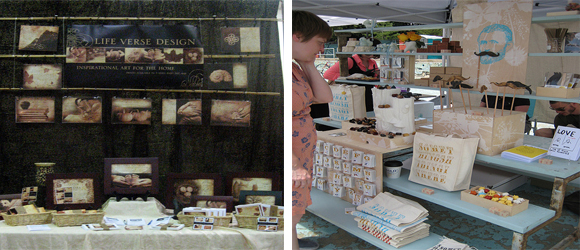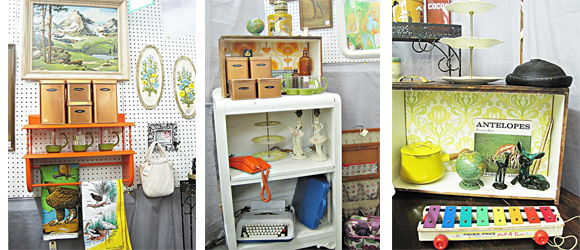by Julie Chen of Life Verse Design
I am here to encourage you to try your hand at your local arts & crafts shows and farmer’s markets. Depending on your product, research, and salesmanship, you could have a great deal of success at these local venues. I personally have sold much more at local shows than I ever have on my Etsy site, though I know this is not the case for all. So, here are some tips to get you thinking if this is an avenue you would like to pursue:
1. Pro: You can make a lot of money at a show. Think of the entry fee as renting a store front for a day or two. Divide it up to an hourly rate to see if you think it is worth it. My average show entry fee is $100. Could you rent a store for that cheap?!
 photos from Life Verse Design and Etsy
photos from Life Verse Design and Etsy
2. Con: one word, inventory. The beautiful thing about Etsy is that you create an item once you know it has sold but, when stocking a “store” for a day, how many of each item should you bring? Arts and crafts shows require a lot of upfront work in manufacturing your product, displaying it, and packaging it to be ready to be sold. The risk lies in how much money you need to invest up-front, but in the end, it may be well worth it!
3. Pro: networking. Stock your booth with business cards and promotional materials to visually remind booth visitors of your work. I have had many orders come through months later from people who remembered my art from a show.
 photos from atouchofvintage Flikr photostream
photos from atouchofvintage Flikr photostream
4. Con: Again, the money you need to invest in your booth. If and when you do a show you will need to have an entire booth ready to showcase your craft. That takes money and creativity but it is a fun challenge. A typical booth is 10×10 feet, which essentially holds 3 6 foot long tables in the shape of a “U”. You will need tables, table cloths, your inventory, ways to visually display your work, shopping bags, etc.. and all done to create a unique environment that speaks of your specific product. In my booth, I have created a mix of natural elegance, utilizing baskets to hold art as bins, bamboo poles to hang the art up so that the buyer has more to see as they glance through my “shop”, and rich colored table clothes and easels to create refined elegance. I want my customers to be able to picture my work in their home.
5. Pro: people specifically come to arts and crafts show to buy things. Though there are some window shoppers, I think arts and crafts shows are differ from retail stores in that people passionately follow them and come ready to buy. I highly suggest taking credit cards, as at least half of my sales are done as credit card transactions. I have been amazed at how in the last three years of doing shows, I see the same customers follow me around. People who shop these types of venues are loyal customers.
 photos from My Fantastic Toys blog
photos from My Fantastic Toys blog
6. If you are ready to take the risk of creating a travelling store, the last thing I would suggest for now is to do your research. Take time this summer or fall to just simply go to your local arts and crafts shows to see if you think your work would sell well there. Watch the shoppers. Are they your clientelle? Look at the vendors. Are they good quality and creative? Ask how many years the show has been running. The longer, the better as stated earlier, they will most likely have the biggest following. Talk to some of the vendors you admire to ask them if they like this show, if they sell well here, and what other local shows do they suggest?
In my next post about arts & crafts fairs, I will get down to the nitty-gritty and practical side of what to take to a show and how to prepare.
Here is a photo stream of booths to get some ideas for yours:
http://www.flickr.com/groups/715724@N24/
This site is a good resource to search for shows in your area, the website is hard to navigate & not well designed, but it is the most comprehensive list of shows & info I have found: www.eventlister.com
Another great article is this one from Etsy on “Craft Show Display Tips & Must-Haves“.

